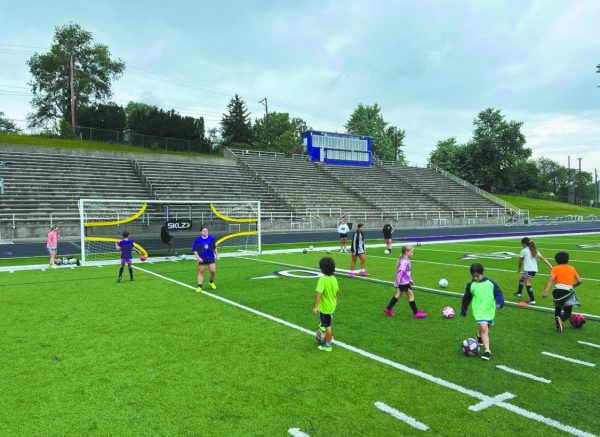Sweat pouring down your face. Breathing hard. Muscles sore from the ache of hard work. Most importantly, a smile on your face because you’re able to participate in an activity you love.
Student-athletes engage in physically demanding activities that teach essential lessons about teamwork, determination, and training. However, student-athletes are unable to receive one of their required physical education credits from participating in a sport. They’re forced to take on P.E. during the season or enroll in a meaningless summer school P.E. class when they are already being physically active every day. While many athletes participate in sports because they enjoy it, they deserve to be recognized for their hard work and physical activity. Sports should count as a P.E. credit.
Firstly, the amount of time student-athletes spend on their sport typically exceeds the time spent on a physical education class. A semester-long P.E. class involves around 64.5 hours spent on physical activity. A summer school P.E. class entails about 52.5 hours on physical education.
Now, let’s look at sports. While different sports vary in practice length and times, I’ll use cross-country, the sport that I participated in this fall, as an example. In 2023, we had 53 days of practice in one season, with each practice being roughly 1.5 hours. This adds up to 79.5 hours. That’s 15 more hours than a semester-long P.E. class and 27 more hours than summer school P.E.– not even counting meets or summer conditioning. So even if a student-athlete does the bare minimum by simply attending practice sessions, they are already participating in far more physical activity than students enrolled in regular P.E.
It’s not just about the time spent on physical activity. According to the Nebraska Department of Education, quality physical education programs should “increase the physical competence, health-related fitness, self-responsibility, and enjoyment of physical activity for young people.” Additionally, the Department says that physical education should include skill development, regular physical activity, strengthened peer relations, and goal setting.
Sports do all this and more. As a student-athlete myself, I can attest to the educational benefits of sports. Through participating in cross-country and track and field, I have exercised regularly, made friends, gotten fitter, and set personal goals. My coaches have taught me about running form, healthy eating, the importance of rest and recovery, race strategies, and goal setting. And it’s not just running– my team has worked on strength training, yoga, stretching, and more. Sports have taught me so much about physical activity and set the stage for me to pursue running as a lifelong pursuit.
There is no question that sports provide comprehensive physical education. However, the mechanics of counting a sport as a P.E. credit may be trickier. The Nebraska Department of Education states that “practice for and participation in interscholastic athletic activities are not accepted as a substitute for any part of the personal health and physical fitness requirement.” So essentially, sports and other extra-curricular activities cannot be counted as P.E. credits. But that raises many questions. For example, what about JROTC, a co-curricular activity in which students participate in weekly physical activity? JROTC students receive a physical education credit for their hard work and training. It shouldn’t be any different for sports. If the issue is that sports are not a class, perhaps students could log their practice hours as part of an online class. One example of a district that counts sports as P.E. credits is Bellevue Public Schools in Washington. In that district, students can earn a semester of P.E. credit for “participating in a sport at school or in the community.” The student must log 80 hours of physical education, which must be approved by both coach and parent, as well as demonstrate proficiency on a P.E. exam. This is a straighforward, accountable way of allowing student-athletes to recieve P.E. credit for their sport. It would be simple to create a similar tracking system for our district where students who participate in sports could recieve credit for their practice time.
And it’s not just sports– other physically intensive activities, such as marching band, dance, and cheer, should be counted as a P.E. credit too. Dance and cheer both follow similar after-school practice patterns as sports. They aren’t just waving around pom-poms– dance and cheer are often competitive activities that require more intense training and physical endurance. Marching band, as well, is not only a class period, but consists of at least eight hours of after-school practice a week. Marching band members run, dance, and, well, march– all of which are physically demanding activities.
Counting sports and other physically intensive activities as P.E. credit would encourage more people to participate in these activities. Our school would likely become more competitive in athletics. Students would get more involved and try new things. Athletes could focus on a sport or activity they enjoy, setting real-life goals for themselves and bonding with a team. Rather than having to cut summer conditioning short for summer school P.E. or show up to practice already exhausted from a P.E. class, these athletes could simply enjoy the sport that they are already a part of.
My freshman year of high school, I had to leave cross-country summer conditioning early so I could make it to summer school P.E. on time. I would run three, four, five miles in the morning, but since apparently that’s not considered enough physical activity to be worth a P.E. credit, I had to give up valuable training time to walk around and play pickleball. Don’t get me wrong, these activities can be great ways for students to participate in physical activity. But it doesn’t make sense that a student-athlete like myself has to do them on top of a sport. This past summer, when I wasn’t enrolled in summer school, I could push myself to run further and even do strength training after summer conditioning. Not counting sports as P.E. credits can actually limit opportunities for student-athletes to grow and improve.
In conclusion, sports and other physical activities like marching band, dance, and cheer should be counted as a P.E. credit. It simply doesn’t make sense to require extra physical education time on top of student-athletes’ hard work in a sport. Sports cover all aspects of physical education and encourage students to pursue physical activities that they enjoy. It’s time to recognize sports as what they are– true physical education.
![Ensuring safety. If given a reason, the school resource officer reserves the right to search a student’s belongings. As a safety precaution, SROs wear gloves when searching a student’s backpack. “So [for a] backpack search, if we have to do a backpack search, we have to have a few things. We have to have existent circumstances, probable cause, or we have to have reasonable articulable suspicion which we would request from the school administrator or teacher to search a backpack,” School Resource Officer Jonathan Hobbs said.](https://thechieftainspear.org/wp-content/uploads/2024/05/hobbs-photo-Medium-450x600.jpeg)









